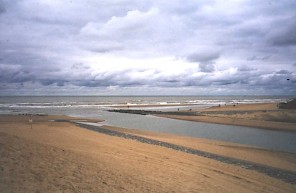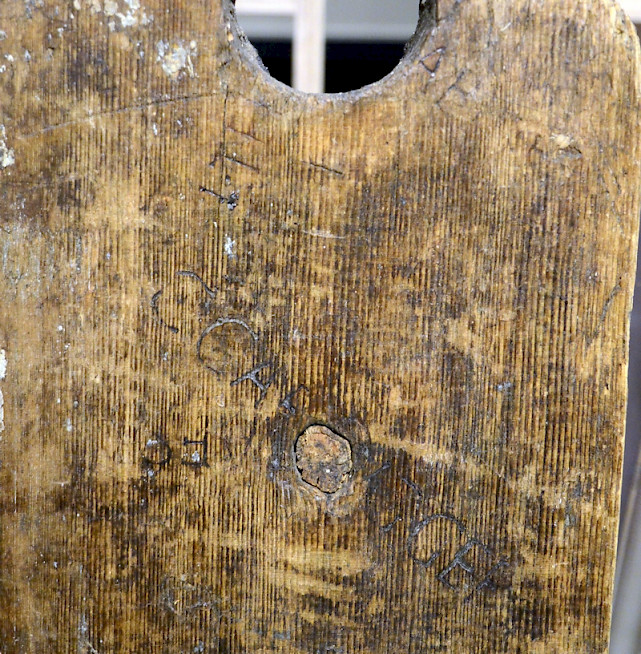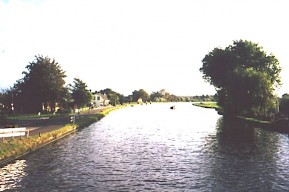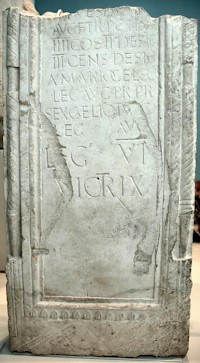Germania Inferior (4)
Q152136Germania inferior: small province of the Roman empire, situated along the Lower Rhine. Its capital was Cologne.
The western border

The Rhine was Germania Inferior's eastern and northern frontier. We do not know, however, where the other border was, in the west. The crucial point is whether Tongeren and the tribe of the Tungri belonged to Gallia Belgica or Germania Inferior.
The answer to this old question is that they were Belgians. During the reign of Marcus Aurelius, the Chauci, a Germanic tribe that lived along the shores of the Wadden Sea in what is now the Dutch province of Groningen and the German Ostfriesland. They had a reputation for piracy, and unexpectedly invaded the country that is now called Flanders. From the Historia Augusta (a collection of biographies of Roman emperors), we know that the governor of Belgica, a man named Didius Julianus, recruited troops in his province and attacked the invaders.note One fortified camp has been excavated near Maldegem (east of Bruges), and can dendrochronologically be dated to 173.
It offered accommodation to a squadron of Tungrian cavalry. This proves that the Tungrians belonged to the country where Didius Julianus could find his soldiers: Belgica.
Caligula and Corbulo

At the end of the second part of this article, we saw how the Roman province was more or less established as an independent military zone within Gallia Belgica. In the third part, we have so far discussed the military presence and the borders of Germania Inferior. The province is not often mentioned in our sources, and it is impossible to write a real history of the region. However, several incidents from the first century are known to us.
The first of these is the state visit of Caligula to the Dutch coastal area. In 37, he had succeeded his uncle Tiberius as emperor of Rome. The new ruler was the son of Germanicus, a grandson of both Drusus and Marcus Vipsanius Agrippa, and by adoption a great-great-grandson of Julius Caesar. All his ancestors had fought against the Germanic tribes, and Caligula must have felt a moral obligation to launch a northern expedition too.
In 40, he invaded the country of the Chatti on the east bank of the Rhine. Our sources describe the operation as some sort of joke by an insane emperor, but this is probably incorrect. At Wiesbaden on the east bank of the Middle Rhine, archaeologists have excavated the remains of a fort built in these years.
But Caligula's campaign was very brief, and during the autumn, he was on the move again and arrived at the ocean shore. The following story is told by his biographer Suetonius.
Finally, as if resolved to make war in earnest, he drew up a line of battle on the shore of the ocean, placed his ballistas and other artillery, and, no one knowing or able to imagine what he was going to do, he all of a sudden commanded they gather sea shells and fill their helmets and pockets with them [...]. As a monument of this victory, he erected a lofty tower, from which lights were to shine at night to guide the course of ships, as from the lighthouse of Alexandria.note

This farce must have taken place on the beach near Katwijk. In the winter of 39/40, a military base was constructed at Valkenburg near the debouchement of the Rhine. It was called Praetorium Agrippinae; the first word means 'headquarters', the second is a reference to the emperor's mother Agrippina Maior. The presence of the emperor is certain, as a barrel has been found that once contained wine from the emperor's personal vineyards. A similar object was found at nearby Vechten. As late as the sixteenth century, fishermen from Katwijk called a group of underwater ruins 'the tower of Kalla'.
Other building activities are known from Woerden, and it is also known that the Romans rebuilt the naval base near Velsen. In 41, it was used as starting-point for a military campaign against the Chauci. In their country, general Aulus Gabinius Secundus reconquered the eagle standard of one of the legions that were defeated in the battle in the Teutoburg Forest. He received the surname Chaucius.
Corbulo

However, the Chauci were not defeated. During the next years, they looted the unprotected coastal area of Gallia Belgica, and in 46 or 47 attempted an attack on Germania Inferior, probably at the Frisiavones in the Southwest. They were commanded by one Gannascus, a Cananefate by birth. His actions came at the wrong time (for the Romans), because the emperor Claudius, who had succeeded Caligula in 41, had just launched an attack on Britain. He could not use pirates in the Channel.
The governor of Germania Inferior had to take measures. His name was Gnaeus Domitius Corbulo and he was one of the most important senators of his age. According to the Roman historian Tacitus, the general first re-established discipline among the legionaries. This may be true, but it is more likely that this is a topical remark: in ancient literature, all successful generals start their activities by restoring discipline.

However this may be, it is certain that Corbulo used the Rhine fleet (and the legions V Alaudae and XV Primigenia?) to attack the Chauci. First, the Frisians, which had become independent in 28, were subdued again and forced to live at other places. They received Roman laws and were reorganized according to Roman principles. When Corbulo was ready to strike at the Chauci, he received an order from the emperor Claudius that he had to return, because the Rhine was to remain the frontier of the empire. Claudius was occupied in Britain and did not need a second front.

This was not the end of Corbulo's activity in Germania Inferior. The legionaries were ordered to dig a canal between the Rhine and the Meuse. Corbulo's Canal is still in use. It is called the Vliet and can be found between Leiden and Voorburg in the Dutch province Zuid-Holland.
Other building activity took place along the Lower Rhine. In the next decade, some twenty forts were erected between Katwijk and Xanten. At regular intervals between them, there were watchtowers, which served as signal-beacons. Except for interruptions in 69-70, c.240, and 256-260, these fortifications remained more or less intact until the big catastrophe that befell Germania Inferior in 274. The construction of these forts marks a new stage in the history of Germania Inferior. It was a line of defense (limes). The Romans had finally decided not to conquer the east bank of the Rhine.
The Batavian revolt

After this incident, Germania Inferior disappears from our sources, except for a brief visit of two Frisian kings to Rome, where they caused some laughter because of their odd behavior in the theater of Pompey (58). However, in 67, the Rhine army suddenly became one of the most important powers in the Roman world.
In that year, the position of the emperor Nero (who had succeeded his stepfather Claudius in 54) became untenable: many senators were discontent and several governors discussed his removal. Among these were Lucius Clodius Macer of Africa and Gaius Julius Vindex of one of the provinces in Gaul, who supported the governor of Hispania Tarraconensis, Servius Sulpicius Galba, when he proclaimed that he wanted to dethrone Nero.
This was treason, and the army of Germania Inferior knew what it had to do: it marched to the south and defeated Vindex. The soldiers expected to be rewarded, but were disappointed: Galba marched on Rome, the Senate recognized him, and Nero committed suicide (June 68). What had been exemplary behavior, was now explained as an attempt to obstruct the accession of the new emperor.
Therefore, the army of Germania Inferior acclaimed their own commander, Vitellius, as emperor, and marched on Rome (January 69). It was successful, and Vitellius started his reign. However, in the east, general Vespasian had also decided to make a bid for power; the two armies clashed near Cremona in northern Italy, where the Rhine army turned out to be no match for the soldiers of Vespasian.

Meanwhile, in Germania Inferior, a disaster was in the making. The Batavians felt offended because Galba had dismissed his Batavian bodyguard, and revolted. Their leader was Julius Civilis. A Roman expeditionary force, consisting of the remains of V Alaudae and XV Primigenia, was defeated near Nijmegen, and not much later, these two legions found themselves besieged at Xanten. Although I Germanica, XVI Gallica and a legion from Germania Superior, XXII Primigenia, tried to rescue them, the two legions at Xanten were forced to surrender in March 70. Not much later, I Germanica and XVI Gallica surrendered as well.
It took several months before the new emperor Vespasian could send a strong Roman army to recover the Rhineland and suppress the Batavian revolt, commanded by his relative Quintus Petillius Cerialis. A monument erected at Xanten by VI Victrix commemorates its victory over the Batavians.
The Batavians suffered terribly for their support of Julius Civilis. Every family mourned because of the death of at least one son. The Frisians and Cananefates had to pay the same human toll. During the war, the Batavian capital Nijmegen had been destroyed, and the inhabitants were ordered to rebuild it two kilometers downstream on a place where it could not be defended. The Tenth legion Gemina was stationed close by, as a permanent guard.